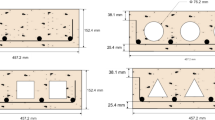Abstract
Concrete creep under both static and cyclic loading conditions was investigated. Four groups of high-strength high-performance concrete (HSHPC) prism specimens were fabricated, and three of these specimens were loaded periodically by the MTS Landmark Fatigue Testing Machine System. Creep characteristics and creep coefficients of HSHPC under static loading and cyclic loading, respectively, were obtained and compared. The experimental results show that the creep strains under cyclic loading with a mean stress of 0.4 fcp and an amplitude of 0.2 fcp increase significantly compared with the creep strains under static loading, and the maximum value was 1.2–2.3 times at early stages. In addition, the creep coefficient increases nonlinearly with the number of cyclic loading repetitions. The influence coefficient for cyclic loading γcyc=1.088×(N/N0)0.078 was introduced based on the previous HSHPC creep model, and then the modified creep model under cyclic loading was established. Finally, the residual method, the CEB coefficient of variation method and the B3 coefficient of variation method were applied to evaluate the modified creep model. The statistical results demonstrate that the modified creep model agrees well with the experimental measurements. Hence, it has important theoretical and practical values for accurately predicting the deflection of concrete bridges under cyclic traffic loading.
Similar content being viewed by others
References
Bažant Z P, Hubler M H, Yu Q. Excessive Creep Deflections: An Awakening[J]. Concr. Int., 2011, 33(8): 44–46
Bažant Z P, Yu Q, Li G H. Excessive Long-Time Deflections of Prestressed Box Girders. I: Record-Span Bridge in Palau and Other Paradigms[J]. J. Struct. Eng., 2012, 138(6): 676–686
Bažant Z P, Yu Q, Li G H. Excessive Long-Time Deflections of Prestressed Box Girders. II: Numerical Analysis and Lessons Learned[J]. J. Struct. Eng., 2012, 138(6): 687–696
Bažant Z P, Hubler M H, Yu Q. Pervasiveness of Excessive Segmental Bridge Deflections: Wake-Up Call for Creep[J]. ACI Struct J., 2011, 108(6): 766–774
Comite Euro-Iternational Du Beton. CEB-FIP Model Code for Concrete Structures[S]. CEB Bulletin No. 124/125-E, 1978
Comite Euro-Iternational Du Beton. CEB-FIP Model Code 1990[S]. CEB Bulletin D’Information No. 213/214, 1993
ACI Committee 209. Prediction of Creep, Shrinkage and Temperature Effects in Concrete Structures[S]. ACI 209R-92, 1992
Gardner N J, Zhao J W. Creep and Shrinkage Revisited[J]. ACI Mater J., 1993, 90(3): 236–246
Gardner N, Lockman M J. Design Provisions for Drying Shrinkage and Creep of Normal-Strength Concrete[J]. ACI Mater. J., 2002, 98(2): 159–167
Bažant Z P, Baweja S. Creep and Shrinkage Prediction Model for Analysis and Design of Concrete Structures Model B3[J]. Mater. Struct., 1995, 28(6): 357–365
Bažant Z P, Baweja S. Creep and Shrinkage Prediction Model for Analysis and Design of Concrete Structures Model B3[J]. Mater. Struct., 1996, 29(2): 126–126
Bažant Z P, Baweja S. Justification and Refinements of Model B3 for Concrete Creep and Shrinkage 1. Statistics and Sensitivity[J]. Mater. Struct., 1995, 28(7): 415–430
Sellier A, Multon S, Buffo-Lacarriere L, et al. Concrete Creep Modeling for Structural Applications: Non-Linearity, Multi-axiality, Hydration, Temperature and Drying Effects[J]. Cem. Concr. Res., 2016, 79(1): 301–315
Bažant Z P, Hubler M H. Theory of Cyclic Creep of Concrete Based on Paris Law for Fatigue Growth of Subcritical Microcracks[J]. J. Mech. Phys. Solids., 2014, 63: 187–200
Probst E. The Influence of Rapidly Alternating Loading on Concrete and Reinforced Concrete[J]. The Structural Engineer, 1931, 9(12): 410–429
Whaley C P, Neville A M. Non-Elastic Deformation of Concrete Under Cyclic Compression[J]. Mag. Concr. Res., 1973, 25(80): 145–154
Hirst G A, Neville A M. Activation Energy of Creep of Concrete Under Short-Term Static and Cyclic Stresses[J]. Mag. Concr. Res., 1977, 29(98): 13–18
Koh C G, Ang K K, Zhang L. Effects of Repeated Loading on Creep Deflection of Reinforced Concrete Beams[J]. Eng. Struct., 1997, 19(1): 2–18
Gaede K. Versuche über die Festigkeit und die Verformungen von Beton bei Druck- Schwellbeanspruchung[M]. Berlin: Deutscher Ausschuß für Stahlbeton, 1962
Ghali A, Gayed R B, Kroman J. Sustainability of Concrete Infrastructures[J]. J. Bridge Eng., 2016, 21(7): 1–11
Pan Z F, Lu Z T, Fu C C. Experimental Study on Creep and Shrinkage of High-Strength Plain Concrete and Reinforced Concrete[J]. Adv. Struct. Eng., 2011, 14(2): 235–247
Pan Z F, Meng S P. Three-Level Experimental Approach for Creep and Shrinkage of High-Strength High-Performance Concrete[J]. Eng. Struct., 2016, 120: 23–36
Liu M Y, Li Q, Huang Y B, et al. Ultra-Long Time Performance of Steel-Concrete Composite Continuous Beam in Hong Kong-Zhuhai-Macao Bridge with Creep and Shrinkage of Concrete Slabs[J]. China J. Highw. Transport., 2016, 29(12): 60–69
Pan Z F, Li B, Lu Z T. Re-Evaluation of CEB-FIP 90 Prediction Models for Creep and Shrinkage with Experimental Database[J]. Constr. Build Mater., 2013, 38(2): 1 022–1 030
Muller H S, Hilsdorf H K. Evaluation of the Time-Dependent Behavior of Concrete, Summary Report on the Work of General Task Group No. 199[M]. Switzerland: CEB Bulletin’ Information, 1990
Author information
Authors and Affiliations
Corresponding author
Additional information
Supported by Key Project of Chinese National Programs for Fundamental Research and Development (No. 2017YFB 0310105-03), Key Foundation Projects of Hubei Province (No. 2016CFA074) and Technology Innovation Major Project of Hubei Province (No. 2018AAA001-04)
Rights and permissions
About this article
Cite this article
Li, Q., Liu, M., Lu, Z. et al. Creep Model of High-Strength High-Performance Concrete Under Cyclic Loading. J. Wuhan Univ. Technol.-Mat. Sci. Edit. 34, 622–629 (2019). https://doi.org/10.1007/s11595-019-2096-9
Received:
Accepted:
Published:
Issue Date:
DOI: https://doi.org/10.1007/s11595-019-2096-9




